Revisit submergence of ice blocks in front of ice cover-an experimental study *
Jun Wang (王軍), Yi-fan Wu (吳一帆), Jueyi Sui
1. College of Civil and Hydraulic Engineering, Hefei University of Technology, Hefei 230009, China
2. Environmental Sciences and Engineering Program, University of Northern British Columbia, Prince George,BC, Canada
Introduction
The river ice is an important hydrologic factor in the temperate and polar environments. An ice cover alters the hydraulics of an open channel by imposing an extra boundary for the flow, changing the flow depth and the flow velocity as compared with those under the ice free conditions[1,2]. Under specific conditions such as with a continuous vast amount of incoming frazil ice from upstream due to very low air temperature and in a highly turbulent flow, the ice jam may be formed, to result in a significant increase of the water level, accompanied with the ice flooding,and the damage of hydraulic structures. Without doubt,the changes of the water level caused by the river ice jams attract interest of many researchers and engineers in the world. Generally, the development of an ice jam might be due to the following processes[3]: (1) when the incoming ice blocks/frazils approach the front edge of the ice cover, depending on the flow conditions, some ice blocks and ice pans might be entrained by the water and submerged and then accumulated under the ice cover, (2) the ice jam can be formed by the collapse of the ice cover to result in a congestion of broken ice blocks in the channel,normally in a bend channel or in front of bridge piers or point bars during the river breakup.
Ashton[4]pointed out that the critical flow velocity for the entrainment of the ice block in front of the ice cover ranged from 0.60 m/s to 0.70 m/s.
To study the entrainment of the ice block in front of an ice cover,Sinotin and Grentinm[5] carried out physical model experiments in laboratory. They derived the following formula for determining the critical flow velocity (VC) for entrainment of the ice block in front of an ice cover

whereLis the length of the ice block.Ashton[4]pointed out that the critical Froude number
Using the data obtained from experiments,(FrC) for the entrainment of the ice block in front of an ice cover only depends on the ratio of the thickness of the ice block to the water depth under the ice cover(t/h) provided that the frontal ice cover is not submerged under the water. Ashton[4]claimed that the critical Froude number for the entrainment of the ice block is hardly related to the ratio of the thickness of the ice block to the length of the ice block (t/L). He developed the following formula for determining the critical flow Froude number for entrainment of the ice block in front of an ice cover:

Based on the field measurements of the submergence of ice blocks in front of an ice cover in the Hequ Reach of the Yellow River and experiments in laboratory, Sui et al.[6-9]studied the impacts of flow Froude number on the formation of ice jam and ice accumulation. They found that the critical Froude number for the entrainment of the ice block in front of an ice cover depends not only on the ratio of the thickness of the ice block to the water depth under the ice cover, but also on the ratio of the thickness of the ice block to the length of the ice block. They derived the following formula for determining the critical flow Froude number for the entrainment of the ice block in front of an ice cover

Based on the continuity equation, Pariset et al.[3]studied the critical condition for the entrainment of the ice block in front of an ice cover. With the ice Froude number (Fri) as the variable to determine whether or not an ice block will be entrained in front of an ice cover, it is shown that

Wang[10-12]carried out experiments to study the critical condition for the entrainment of the ice block in front of an ice cover. Also with the ice Froude number as the variable, he determines if the ice block will be entrained in front of an ice cover. Based on the data obtained in laboratory, he found that the critical ice Froude number is a function of the dimension of the ice block as follows

By measuring the pressure difference and the pressure distribution under a floating ice block in laboratory, Ambtman et al.[13]used the method of the moment equilibrium to study the stability of the ice block in front of an ice cover.
Using the experimental data from Ambtman et al.[13], Lian et al.[14]carried out numerical simulations.Based on Ashton’s formula (Eq. (3)), they derived the following formula for assessing whether or not the natural broken ice block can be entrained in front of an ice cover

The coefficientKranges from 1.15 to 1.35.They pointed out thatKtakes the minimum value if the frontal cross section of the ice block assumes a quasi-rectangular shape.
Obviously, it is very important to study the entrainment of the ice block in front of an ice cover,since the submergence of the ice block may result in the formation of the river ice jam. In the present study,based on our experimental data and the data obtained from previous studies, using the method of the moment equilibrium, the critical condition for the entrainment of the ice block in front of an ice cover is further re-visited.
1. Experiment setup
The experimental study is conducted in the flume at Hefei University of Technology. As shown in Fig.1,the flume has a dimension of 26.68 m long and 0.40 m wide. There are 22 observation cross sections (CS)along the flume with an equal distance of 1.2 m. The ice-hoper for adding the model ice into the flume is placed between CS-1 and CS-2. The model ice cube used in this experimental study is made of polypropylene with the mass density of 0.918×103kg/m3, which is nearly the same as the mass density of the natural ice of 0.917×103kg/m3. The model ice blocks used in this experimental study have the following dimensions(length×width×height): 0.02 m×0.02 m×0.01 m, 0.03 m×0.03 m×0.01 m, 0.04 m×0.04 m×0.01 m and 0.06 m×0.06 m×0.01 m, respectively, the same sizes (the same dimensions) as those used by Healy and Hicks[15].The flow depths are 0.10 m, 0.15 mand 0.20 m, respectively. The average approaching flow velocities are: 0.05 m/s, 0.07 m/s, 0.09 m/s, 0.11 m/s,0.12 m/s, 0.13 m/s, 0.14 m/s, 0.15 m/s, 0.16 m/s, 0.17 m/s,0.18 m/s, 0.20 m/s and 0.22 m/s, respectively.

Fig.1 The setup of the flume for experiments in laboratory
In the downstream channel section from CS-21 to CS-22, one styrofoam plate is placed on the water surface as the model ice cover. The blockage of the model ice cover in downstream will initiate the formation of the ice cover which consists of ice blocks/cubes. This ice cover will progress upstream,depending on the initial hydraulic conditions, such as the flow velocity and the ice discharge.
Experiments show that the amount of ice blocks entrained under the ice cover can be classified into the following four entrainment levels, “a few ice blocks”,“some ice blocks”, “many ice blocks” and “none ice blocks”. If the flow velocity is low enough or the ice block is large enough, the ice blocks can not be entrained, as shown in Fig.2(a). In this case, the ice jam can not be formed. If only a few ice blocks can be entrained under the ice cover, it means that either the flow velocity is low or the size of the ice block is large. In this case, the ice cover is formed by the juxtapositioning blockage process of ice blocks. Normally, the thickness of the ice cover is the thickness of an individual ice block. Forced by the flowing current,the entrainment process of ice blocks is normally a sliding movement from the frontal edge of the ice cover to the bottom of the ice cover, as shown in Fig.2(b). With the increase of the flow velocity or the decrease of the ice block size, the amount of ice blocks entrained under the ice cover increases to achieve the entrainment level of “some ice blocks”.With further increase of the flow velocity or decrease of the ice block size, the movement of the entrained ice blocks is changed from “slide under the ice cover”to “semi-rolled” under the ice cover, as shown in Fig.2(c). When the flow velocity is high enough or the ice block size is small enough, the amount of ice blocks entrained under the ice cover will be further increased to reach the entrainment level of “many ice blocks”.One can see from the experiments that the majority of incoming ice blocks from upstream will be entrained and forced by the water to “roll” under the ice cover,as shown in Fig.2(d). Only small amount of ice blocks can be stopped by the ice cover and accumulated in front of the ice cover.
2. Forces acting on ice blocks in front of ice cover
2.1 Rolled entrainment of ice blocks
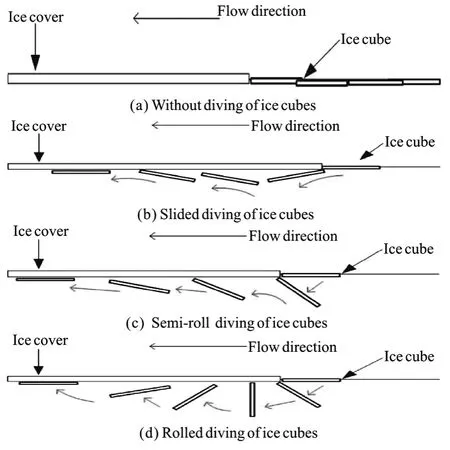
Fig.2 Diving/submerge of ice blocks in front of ice cover
If the ratio of the ice block thickness to the ice block length (t/L) is more than 0.1 but less than 0.8,namely, 0.1<t/L<0.8, the ice block will be rotated at the lower corner (in contact with the ice cover)during the entrainment process, as shown in Fig.3.
To assess whether or not an ice block will be rotated to submerge under the ice cover, the forces acting on an individual floating ice block in front of the ice cover are analyzed. When an ice block moves with the speed ofVtoward the frontal edge of the ice cover, all forces acting on the ice block are as shown in Fig.4.
Conceptually, the following forces are acting on an ice block at the frontal edge of the ice cover: the drag force, the lifting force, the gravity force, the collision forces between the ice block and the frontal edge of the ice cover, and the hydrodynamic pressure force, as shown in Fig.4. The method of the moment equilibrium is used to study the stability of an individual ice block at the frontal edge of the ice cover.Special attention should be paid on the moments produced by the hydrodynamic pressure force, the drag force and the collision forces between the ice block and the ice cover.
(1) The drag force acting on an individual ice block caused by the water can be determined by the following equation

Fig.3 The “rolled” entrainment process of ice block in front of ice cover
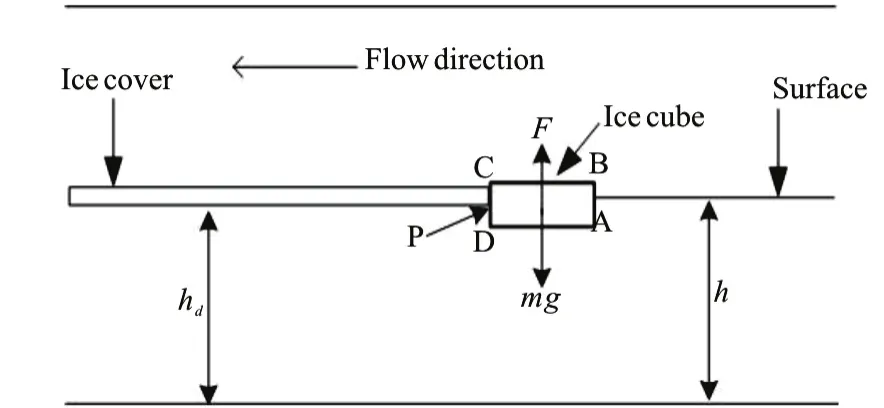
Fig.4 Forces acting on an ice block

whereCDis the drag coefficient,Vis the moving speed of the ice block,Ais the cross sectional area of the ice block which is perpendicular to the flow direction. According to Pang[16], the drag force acting on an individual ice block can be further expressed as

wheret,Landbare the thickness, the length and the width of an individual ice block, respectively.
The moment generated by the drag force (MD)on an individual ice block is

(2) If the mass of an individual ice block (M)and the duration time of the collision (T) between an individual ice block and the frontal edge of the ice cover are known, the collision force between an individual ice block and the ice cover can be determined by the following equation

From the theorem of the kinetic energy, the total work (W) done by the collision force during the collision process between an individual ice block and the frontal edge of the ice cover is

wherex0is the moving distance of an individual ice block during the collision. Since the collision force can be further expressed as

Thus, the moment resulted from the collision force between an individual ice block and the frontal edge of the ice cover is

(3) Dow Ambtman et al.[17]studied the pressure distribution under an ice cover. The hydrodynamic pressure force under the ice cover (FL)mainly consists of the Venturi pressure forces (FV) and the effective stress at the frontal edge of the ice cover(FE):
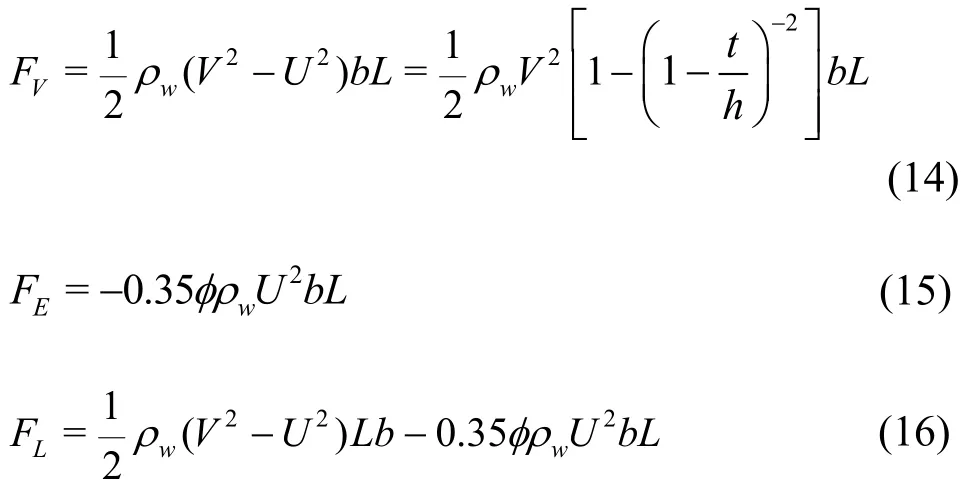
wherehis the water depth, φ is the reduction factor,Uis the flow velocity beneath an individual ice block,Vis the flow velocity in front of the frontal edge of the ice block. In their study, Ambtman and Hicks[17]definedX50such: when the difference between the initial pressure and the Venturi pressure is 50%, then,X50is the distance from the frontal edge of the ice block to the point. According to Song et al.[18], the reduction factor changes with bothLandX50, (1) whenL<0.5X50, then φ=1.0, (2)when 0.5X50<L<3.0X50, then φ=0.5, (3) whenL>3.0X50, then φ=0.2. In the present study, φ=0.5. Thus, the moment generated from the pressure force from the bottom of the ice block (ML) can be calculated as follows:

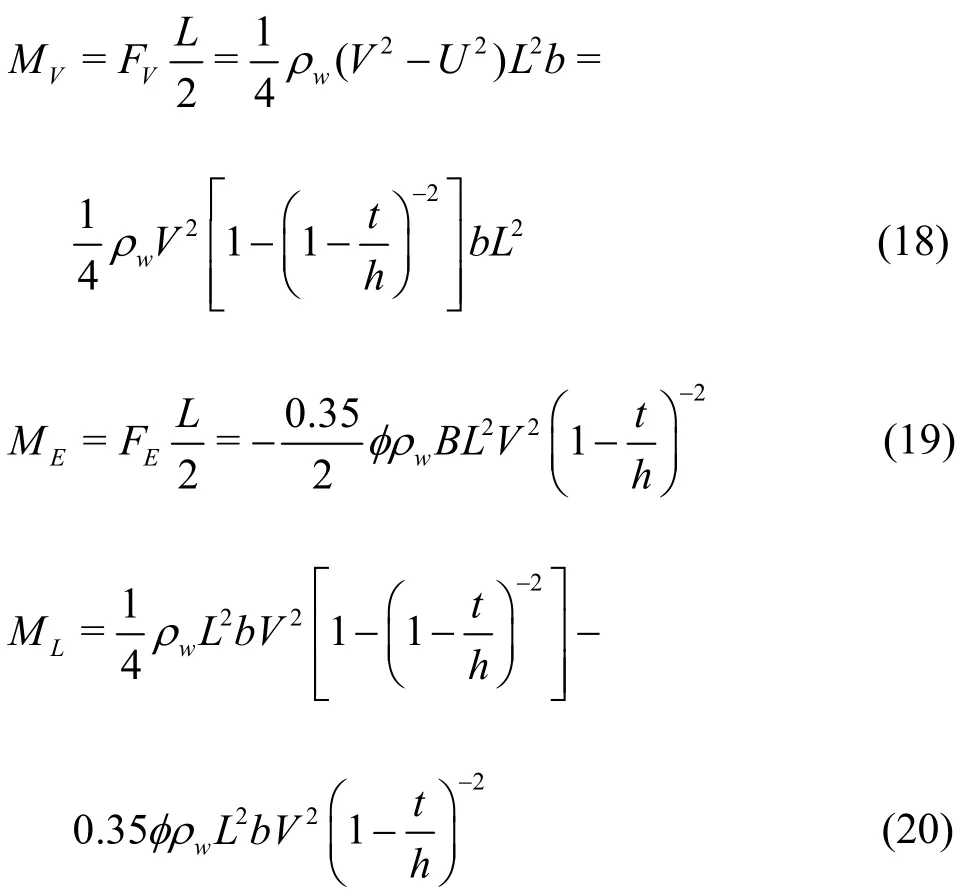
Based on experiments carried out in laboratory,Uzun er and Kennedy[19]studied the anti-overturning moment (R) based on experiments carried out in laboratories. They pointed out that the magnitude of the anti-overturning moment (R) depends on the angle between the individual ice block and the frontal edge of the ice cover during the overturning process.Here are formulas for calculating the anti-overturning moment (R)
(1) As shown in Fig.3(c), the angle between an individual ice block and the frontal edge of the ice cover (θ1) can be calculated as follows
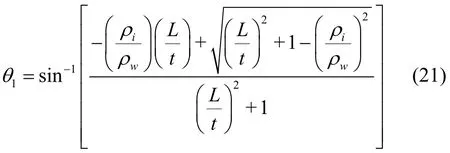
If 0≤θ≤θ1, the anti-overturning moment can be calculated as follows

(2) As shown in Fig.3(d), the angle between an individual ice block and the frontal edge of the ice cover (θ2) can be calculated as follows

If θ1≤θ≤θ2, the anti-overturning moment can be calculated as follows
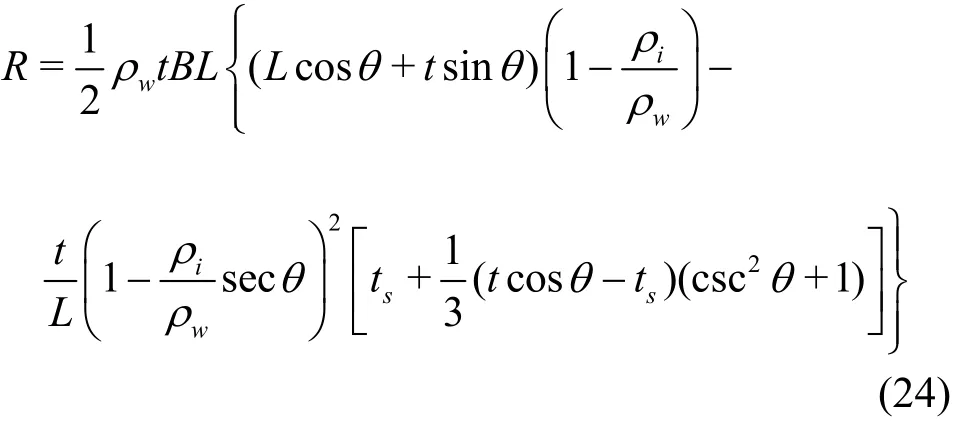
(3) If θ2≤θ≤ π /2, the anti-overturning moment can be calculated as follows

Coutermarsh and Randy Mc Gilvary[20]found that the maximum anti-overturning moment (Rmax) for an individual ice block to be entrained can be expressed as follows

Thus, to determine whether or not an individual ice block will be entrained through the overturning process, the overturning moment (M0) generated from the forces acting on the ice block should meet the following requirement, namely

Therefore, the following formula will be used to determine if an individual ice block is entrained through the overturning (or rolled) process

where

To calculate the critical speed (VC), Eq. (29) is further simplified as the follows:

The existence of the collision force at the frontal edge of the ice cover is responsible for the instability of the ice block, and an overturning moment will be generated. As a consequence, ice blocks become much easier to be entrained and submerged under the ice cover. The above derived equation for determining whether or not an ice block will be entrained under the ice cover is based on the assumption that the ice block width (b) (which is shorter than the ice block length(L)) is in contact with the frontal edge of the ice cover. When the longer side of an individual ice block(namely, the ice block length) is in contact with the frontal edge of the ice cover, the critical speed (VC)for the entrainment of the ice block is:
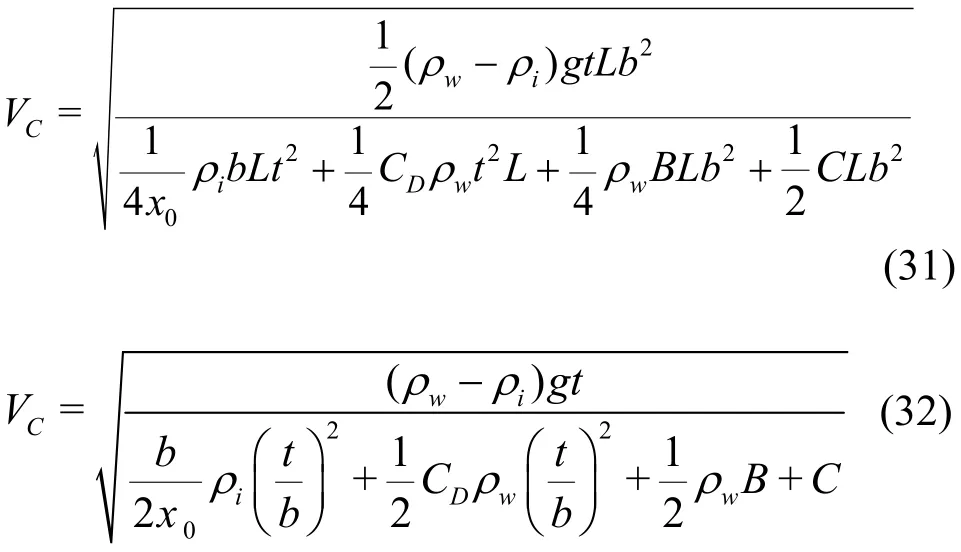
Thus, the critical ice Froude Number for the entrainment of the ice block in front of the ice cover can be expressed as follows

In the present study, due to the low flow velocity,before the entrainment of the ice blocks, they are assumed to be located immediately in front of the ice cover. Thus, the moments generated by the collision force between the ice block and the frontal edge of the ice cover as well as the drag force can be ignored. It means that only the moment generated by the Venturi pressure force will be considered for the entrainment of the ice blocks in front of the ice cover. Thus, Eq.(33) can be simplified as follows

Equation (35) is different from Ashton’s formula(Eq. (3)) due to the difference in evaluating the antioverturning moment. In Eq. (3), the anti-overturning moment (R) is determined when θ=θ1, as follows

In the present study, the maximum anti-overturning moment (Rmax) is used.
Based on the physical model study, Dow Ambtman et al.[17]found that the difference of the hydrodynamic pressure under the ice block consists of not only the effect of the Venturi pressure but also the effect of the frontal edge of the ice cover. Then, Eq.(33) can be simplified as follows

Overally, in all existing studies, either it is assumed that the ice blocks in front of the ice cover are under a stationary condition or under specific conditions before their entrainment. In the present study, however, the critical flow velocity for the entrainment of an individual ice block in front of the ice cover is derived by considering the collision force,the drag force and the hydrodynamics pressure force beneath the ice block.
2.2 Vertical movement of ice blocks during entrainment
Experiments show that, when the ratio of the ice block thickness (t) to the ice block length (L) is in the range of eithert/L<0.1 ort/L>0.8, the ice block is normally forced (by current) to move vertically first. When the top surface of an ice block reaches the same level of the bottom surface of the frontal ice cover, the ice block will be forced to roll and accumulate under the ice cover, as shown in Fig.5.
Through the analysis of the forces acting on an individual ice block, the criteria for the ice block entrainment under the ice cover can be described as follows

where

From Eqs. (37), (38), we obtain


Fig.5 Vertical movement of ice block during entrainment process
In the above section, the entrainment process of ice blocks in front of the ice cover is described by considering the drag force caused by the flowing water, the hydrodynamic pressure force and the collision force between the ice block and the frontal edge of the ice cover. The ice block can be submerged either by the rolled (or rotated) entrainment or the vertical movement entrainment. Formulas for determining the critical flow velocities for the entrainment of the ice block are derived.
3. Experimental results
Clearly, the criteria for the entrainment process of ice blocks in front of the ice cover depend on the dimension of the ice block and the flow velocity. In this experimental study, four types of ice blocks with different dimensions are used to investigate the entrainment process of ice blocks in front of an ice cover.As shown in Fig.6, the length of the ice block is one important factor affecting the flow velocity for the entrainment of the ice block. One can see, the longer the ice block, the higher the flow velocity is needed for the entrainment of the ice block in front of the ice cover.

Fig.6 Relationship between the flow velocity for the entrainment of ice block and the ice block length
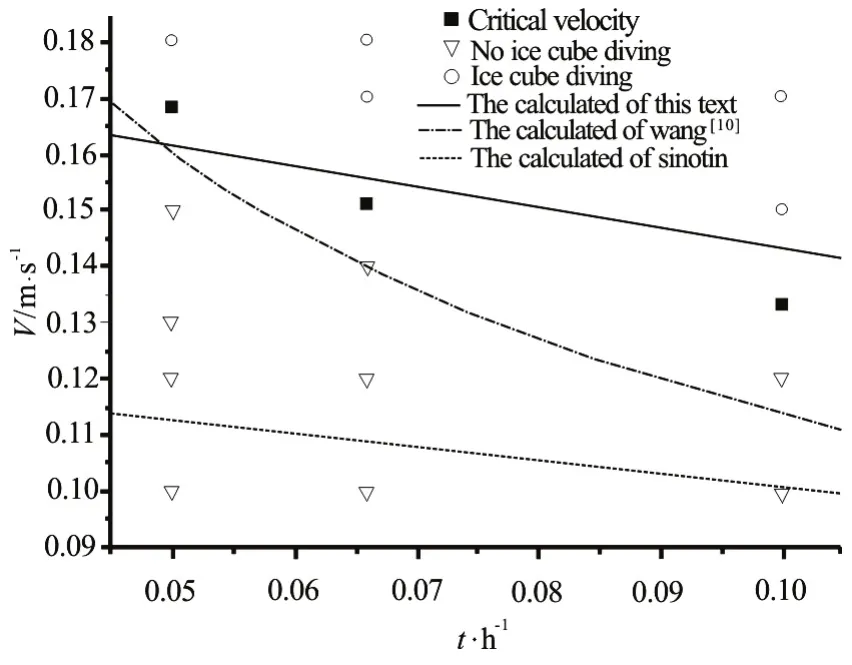
Fig.7 The dependence of critical flow velocity for the entrainment of ice block on the flow depth
By mean of physical models, Sinotin and Grentinm[5]developed one formula for determining the flow velocity for the entrainment of ice blocks in front of an ice cover. As shown in Fig.6, the calculated flow velocities for the entrainment of ice blocks using the formula proposed by Sinotin and Grentinm[5]are much less than the flow velocities measured in our the experiments in the laboratory. The calculated flow velocities for the entrainment of ice blocks using the formula proposed by Wang et al.[10]are much closer to the experiment results than those using the formula proposed by Sinotin and Grentinm[5].
It is shown that the criteria for the entrainment process of ice blocks also depend on the flow depth,as shown in Fig.7. One can see that the critical flow velocity for the entrainment of ice blocks decreases with the increase oft/h.
Ashton developed a formula for calculating the critical flow velocity for the entrainment of ice blocks under specific conditions. In his derivation of the formula, onlyt/his considered, without considera tionb oft/L. It is found that when the ice block is neither so thick, nor so thin, Ashton’s formula could be used to determine the critical flow velocity for the entrainment of ice blocks, with reasonable results.However, in reality, the critical flow velocity for the entrainment of ice blocks not only depends ont/h,but also ont/L.
In the present experimental study, to determine the critical flow velocity for the entrainment process of ice blocks in front of an ice cover, the following four types of ice blocks are used with different dimensions (length×width×height): 0.02 m×0.02 m×0.01 m, 0.03 m×0.03 m×0.01 m, 0.04 m×0.04 m×0.01m and 0.06 m×0.06 m×0.01 m.
According to Uzuner and Kennedy[18], if 0.1<t/L<0.8, the ice blocks will be mainly rolled during the entrainment process. If the ice blocks have the dimension of eithert/L<0.1 (thin ice block) ort/L>0.8 (thick ice block), during the entrainment process, the ice block will be first forced by the current to move vertically, and then, move to the downstream. In the present study, all four types of ice blocks used have dimensions of 0.1<t/L<0.8.Therefore, the ice blocks will be mainly forced to roll during the entrainment process, and Eq. (31) will be used for the calculation.
Table 1 gives the comparison between the calculated flow velocities for the entrainment of ice blocks in front of an ice cover using different formulas and those of measured velocities in laboratory. One can see from Table 1 that the proposed formula in this paper gives the best results.
4. Conclusions
In the present study, using four types of ice blocks with different dimensions, experiments are carried out in laboratory to study the stabilities of ice blocks in front of an ice cover. The critical condition for the entrainment of ice blocks in front of an ice cover is studied by considering the drag force caused by the flowing water, the collision force, and the hydraulic pressure force. Following results are obtained:
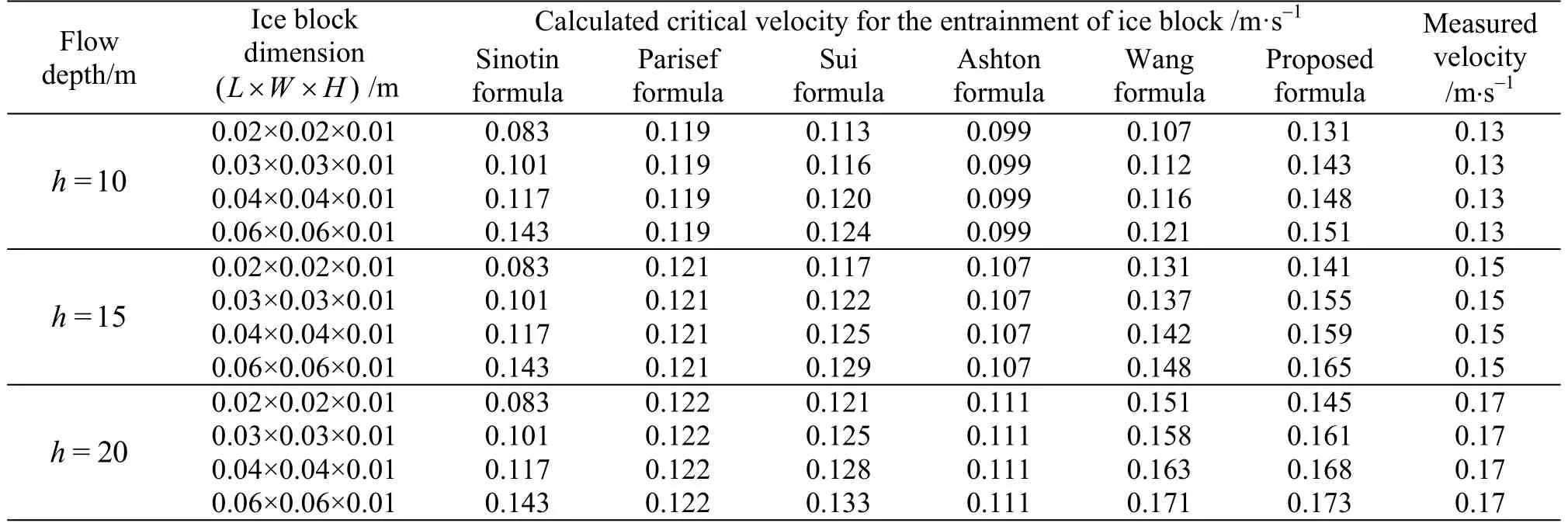
Table 1 Comparisons between calculated critical velocities for the entrainment of ice block using different formulas and the measured velocities
(1) Using the method of the moment equilibrium,the critical condition for the entrainment of ice blocks in front of an ice cover is re-visited. The critical ice Froude number is obtained.
(2) To determine whether or not an ice block will be entrained under the ice cover, botht/handt/Lare considered in deriving the formula for determining the critical velocity for the entrainment of ice blocks.The calculated results by using the proposed formula are compared with the measured velocities in laboratory. The calculated results by using the proposed formula are also compared with those using formulas developed by other researchers. Results indicate that the values obtained by using the proposed formula are in the best agreement with the experimental results.
[1] Fu H., Guo X. L., Yang K. L. et al. Ice accumulation and thickness distribution before inverted siphon [J].Journal of Hydrodynamics, 2017, 29(1): 61-67.
[2] Wang J., Li S. Y., Chen P. P. et al. Impacts of bridge piers on water level during ice jammed period in bend channelan experimental study [J].Journal of Hydrodynamics.2018, 30(1): 160-168.
[3] Pariset E., Hausser R., Gagnon A. Formation of ice covers and ice jams in rivers [J].Journal of the Hydraulics Division,1966, 92(6): 1-24.
[4] Ashton G. D. Froude criterion for ice-block stability [J].Journal of Glaciology, 1974, 13(68): 307-313.
[5] Sinotin V. I., Grentinm Z. A. A study of diving of ice floes under an obstacle [C].Proceedings of the IAHR International Symposium on Ice and Its Action on Hydraulic Structure, Reykjavik, Iceland, 1970.
[6] Sui J., Fang D., Zhou Y. et al. Study of critical submergence of ice blocks in front of ice cover [J].Journal of Hydraulic Engineering, 1993, (10): 46-51(in Chinese).
[7] Sui J., Karney B., Fang D. Variation in water level under ice-jammed condition–Field investigation and experimental study [J].Nordic Hydrology (Now: Hydrology Research), 2005, 36(1): 65-84.
[8] Sui J., Karney B., Sun Z. et al. Field investigation of frazil jam evolution: A case study [J].Journal of Hydraulic Engineering, ASCE, 2002,128(8): 781-787.
[9] Sui J., Wang J., Balachandar R. et al. Accumulation of frazil ice along a river bend [J].Canadian Journal of Civil Engineering, 2008, 35(2): 158-169.
[10] Wang J. Study of stability of ice block in front of ice cover[J].Yellow River,1997, (1): 9-12(in Chinese).
[11] Wang J., Shi F., Chen P. et al. Impacts of bridge abutments on the critical condition for initiation of ice cover-an experimental study [J].Journal of Hydrology and Hydro-mechanics, 2015, 63(4): 327-333.
[12] Wang J., Shi F. Y., Chen P. P. et al. Impacts of bridge pier on the stability of ice jam [J],Journal of Hydrodynamics,2015,27(6): 865-871.
[13] Ambtman K. D., Steffler P. M., Hicks F. E. Analysis of the stability of floating ice blocks [J].Journal of Hydraulic Engineering, ASCE,2011, 137(4): 412-422.
[14] Lian J. J., Luo F. X., Zhao X. Numerical simulation of ice submergence in water conveyance channel [J].Journal of Hydraulic Engineering,2013, 44(6): 673-679(in Chinese).
[15] Healy D., Hicks F. E. Experimental study of ice jam thickening under dynamic flow conditions [J].Journal of Cold Regions Engineering, 2007, 21(3): 72-91.
[16] Pang Q. Experimental study of forces acting on a solid subject in flowing water [D]. Master Thesis, Nanjing,China: Hohai University, 2005(in Chinese).
[17] Dow Ambtman K. E., Hicks F. E., Steffler P. M. Experimental investigation of the pressure distribution beneath a floating ice block [J].Journal of Hydraulic Engineering,ASCE, 2010, 137(4): 399-411.
[18] Song X., Zhao X., Liu B. Numerical simulation of distribution characteristics of water pressure at bottom of submerged ice blocks of channel [J].Journal of WaterResources and Water Engineering, 2014, 25(1): 117-121.
[19] Uzuner M. S., Kennedy J. F. Stability of floating ice blocks [J].Journal of the Hydraulics Division, 1972,98(12): 2117-2133.
[20] Coutermarsh B. A., Randy McGilvary W. Static analysis of floating ice block stability [J].Journal of Hydraulic Research, 1993, 31(2): 147-160.
- 水動力學(xué)研究與進(jìn)展 B輯的其它文章
- Some notes on numerical simulation and error analyses of the attached turbulent cavitating flow by LES *
- Energy dissipation of slot-type flip buckets *
- Transient aerodynamic characteristics of vans during the accelerated overtaking process *
- Numerical analyses of ventilated cavitation over a 2-D NACA0015 hydrofoil using two turbulence modeling methods *
- 2-D eddy resolving simulations of flow past a circular array of cylindrical plant stems *
- Couple stress fluid flow in a rotating channel with peristalsis *

